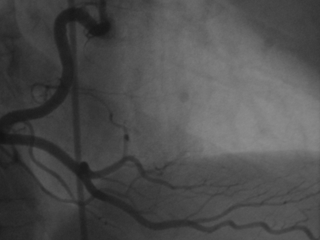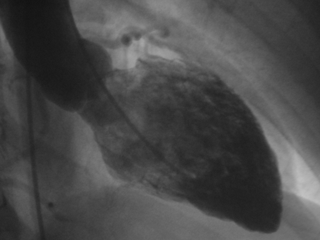What is cardiac catheterization?
Cardiac catheterization is also known as heart catheterization, or coronary angiography. Cardiac catheterization is performed on patients to investigate chest discomfort that may be caused by blockages of the coronary arteries, heart valve abnormalities, or congenital (birth) heart defects.

Catheterization Lab (Cath Lab) 
Left coronary artery angiogram 
Right coronary artery angiogram 
Left ventriculogram in diastole
Who performs the test?
In Canada, this test is performed by trained cardiologists with help from nurses and technicians in the heart catheterization lab (also known as the Cath Lab).
How should I prepare for the test?
If you are diabetic, allergic to any radiographic dye, or you are taking Coumadin (Warfarin), you have to let your doctor know so that he or she will give you appropriate instructions including the medications prior to the procedure. In our hospital you can have a light breakfast the morning of the test. In other hospitals you may be asked not to have any food or drink, including water, after midnight the night before your angiogram.
How is the test performed?
This invasive non-surgical diagnostic test is usually done from the groin or the arm with the patient lying on the back on a special radiographic table. The patient is often given light sedation by pills or by intravenous injections. The skin is frozen by local anesthetics. Small catheters (plastic tubes) about the size of 2 mm in diameter are introduced via the artery and vein and advanced to the heart while being monitored by X-ray on the monitors. Some local pressure may be felt at the catheter insertion site during the test but one should not feel pain. If you feel pain at the puncture site you should let the nurse or physician know so that they can give you more local anesthetics. Radiographic dye is injected into the coronary arteries and the left ventricle while X-ray images are recorded on films or digitally. You may feel warmth, heat or burning over the body when the dye is injected. But this symptom only lasts a minute or two. If one experiences any discomfort, especially any chest discomfort, you should let the doctor or nurse know right away. The actual cardiac catheterization procedure itself usually lasts for 15 to 45 minutes.
What happens after the procedure is completed?
Once the procedure is completed the catheter will be removed in the recovery room with pressure on the groin to prevent bleeding. If the access site is through the groin, you will have to lie flat for four to six hours after the catheter is removed.
During the recovery period, a nurse will check frequently the pulses in the limb and any sign of bleeding. You may have to stay overnight in the hospital for the recovery, especially if you live far away from the hospital. Your doctor will usually go over the result of the test and discuss with you the treatment plan.
What are the risks involved in the test?
The major risks involved in cardiac catheterization, in general, are very low. There is a less than 2 in 1000 chance of having a heart attack, stroke, or death. It is important to understand that a physician will only recommend this diagnostic test only if he or she believes the benefit of knowing the status of the coronary arteries and the heart function far out-weights the risks involved. The information obtained will help your physician to prescribe the best treatment for your condition. Prior to the diagnostic test, the responsible physician will explain the risks involved in this procedure and provide an opportunity for you to ask questions regarding the test. Then you will be asked to sign a consent form indicating that you understand what is involved and agree to the procedure.
(Adapted from a document prepared by the St. Michael’s Cardiac Catheterization Laboratory)
